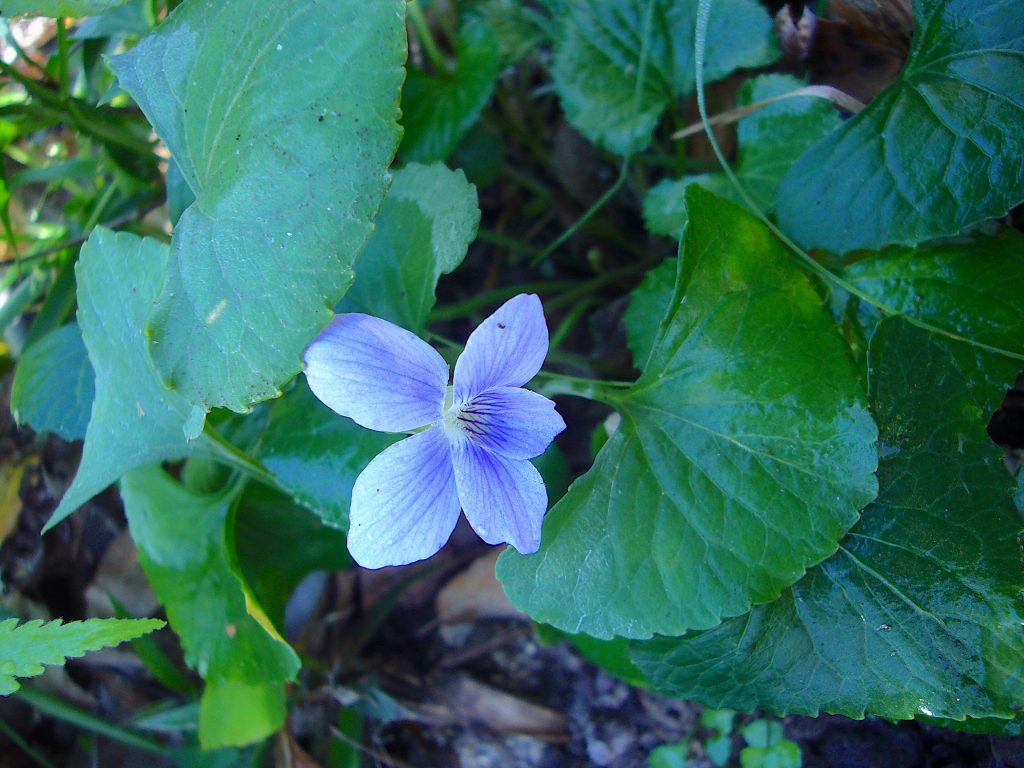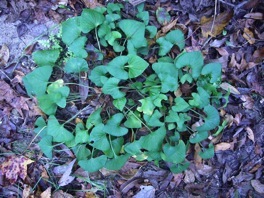
Viola affinis: Florida’s Sweet Violet
My introduction to violets was seeing my mother eat “Piss-a-beds” in the spring (Viola rafinesquii. VYE-oh-lah raff-a-NESK-kee-eye.) They grew in the shade near the smelly cellar drain and were, as you might guess, a diuretic.
For all their presence in Florida I did not see violets for quite a while. More so, they show great variation so getting the right identification can be a bit irritating. Pictured here, I think, is Viola sororia/affinis. (VYE-oh-lah-ROR-ee-uh / aff-EYE-niss.) However, violets are like oak and pine trees, you really don’t need to know which exact species it is as long as you have the right genus. (And just to make sure, we are not talking about African Violets, which are in a different genus completely.)
Violets leaves can be used raw in salads or cooked like spinach. Their flowers can be eaten raw, or candied, the dried leaves can be used to make tea. Violets can also be added to soups as a thickener. In fact, in the 1800’s that was the most common reference for them. While they traditionally blossom in the spring, warmer areas can see them blossom in the spring and late fall. In Central Florida’s winter, Christmas to Valentines, they are quite happy and blooming.
Native Americans had various medicinal uses for some 17 species of violets. Surprisingly there is little record of them eating violets with only three western tribes doing so. They did, however, used violets as poultices for headaches and boils, as an infusion for dysentery, kidney problems, bladder issues, heart pain, colds and coughs (they are high in vitamins A and C.) They were also used for skin problems, as application research confirmed in 1995.
Violet roots, however, are not user friendly. They can clean you out. The Indians soaked them with corn seeds as a pre-planting insecticide. Indeed, violets have long been associated with chemistry. Before there was the “litmus” test there was the violet test for acids and alkalis. And of course, recreating the aroma of violets was a major challenge of the perfume industry.
The name “violet” is often given as from Dead Latin, and it is. However, there is Greek behind that Dead Latin. Contemporary Greeks say violetta — adapted from English — or menekseis. The English word “violet” is from the Dead Latin “viola” the Roman’s name for the plant. However, viola came from the Greek word Vion, which is a variation of Io, (EEoh… Ιω…) the beautiful daughter of Inachus, King of Argos. Io was also priestess to Zeus’ wife Hera. According to Greek legend, Zeus was so smitten by Io that he seduced her after much pursuit and rejection by her. The seduction made his wife, Hera, quite angry. To protect Io from Hera Zeus transformed her into a white heifer. (Ain’t that nice: You’re young, beautiful, you’re seduced by the most powerful god around and then get turned into a cow.) As a heifer, however, Io wept because she had to eat coarse grass. To compensate her for her suffering Zeus changed her tears into sweet-smelling, dainty violets for her to eat. However, Hera was not without her means and caused the earth-wandering Io/heifer to be incessantly bothered by a gadfly.
Mythology notwithstanding, violets have quite a history. Violets were first cultivated in Greece around 400 BC or about the time of Socrates, Hippocrates, and the building of the Acropolis. ( so-CRA-tis, i-po-CRA-tis, a-CROP-po-li ) In fact they were the first commercial flower product. Athens was known as the “violet-crowned city.” The Romans liked violet-flavored wine so much they spent more time cultivating violets than olives, much to the irritation of Horace (65-8 BC.) Violets, associated with resurrection, were secretly planted on Nero’s grave. And when Chopin died in Paris his student, Jane Stirling, bought all the violets she could find in Paris and put them on his grave. That tradition lasts to this day with visitors to his grave leaving violets. [Note: Chopin’s body is in Paris but his heart was removed and resides in Warsaw.] Napoleon was nicknamed the Caporal Violette which he used as a nom de plume along with Pere La Violette. When he died he was wearing a locket of violets taken from the grave of his wife, Josephine. They were her favorite flower, and that of England’s Queen Victoria’s, too. Until the early 1900’s violets were associated with St. Valentine’s Day, not roses. According to the legend, Valentine crushed the violet blossoms growing near his cell to make ink to write messages on violet leaves to his friends, delivered by a dove. He was executed on 14 February 269 A.D.
The state flower of Wisconsin, Rhode Island, Illinois and New Jersey, there are some 850 species of violets, in two large groups, sweet and wood. Sweet is strongly scented, wood less scented but larger than the sweets. At least three violets are native to Florida, V. conspersa, sororia and bicolor. Affinis means “similar to” and is a synonym for sororia, sometimes a variation. Conspersa (kons-PER-sa) is sprinkled, sororia sisterly, and bicolor two colored.
Nutritionally violets have 15,000 to 20,000 IUs of vitamin A per 100 grams serving. See recipes below.
Green Deane’s “Itemized Plant Profile”
IDENTIFICATION: Blossoms blue, violet, yellow, white, shades in between and multi-colored. Five petals, with lowest petal heavily veined and going back into a spur. Low growing, there is a wide variety in the leaf shape. Sweet violets are the most aromatic, wood violets tend to be larger.
TIME OF YEAR: Varies slightly. Sweet violets first in spring, the wood violets. In warmer climates they can blossom again in fall
ENVIRONMENT: Moist shaded areas, partial sun.
METHOD OF PREPARATION: Leaves raw, dried or cooked. Blossoms raw or candied. Yellow violets can be mildly laxative.
Violet Jelly
2 cups fresh violets
2 cups boiling water
Juice of one lemon
1 pack pectin
4 cups sugar
Place the violets blossoms in a glass jar and cover them with the boiling water. Make an infusion with violets and water by placing your blossoms in a glass jar and covering them with boiling water. Put a lid on the jar, and set aside for anywhere between 2-24 hours. The water will turn to an aqua blue. Strain and discard the spent flowers. Add the lemon juice and the mix will change to a pretty pink. (After you do this a time or two, you can sort of judge how much lemon juice to add to get a color that `suits’ you.) Stir in pectin, and bring to a boil. Add sugar, bring to a boil again, and boil vigorously for one minute. Skim if necessary. Pour into sterile jars and seal. Makes approximately 2 1/2 cups jelly.
Violet Syrup
4 cups of violets
2 cups boiling water
6 cups sugar
Juice of one lemon
2 cups water
Place violet flowers in a mason jar and pour boiling water over them. Let sit 24 hours. Strain liquid into a bowl (not aluminum!) squeezing out all the goodness from the flowers. Place sugar, lemon juice and water in a saucepan and boil into a very thick syrup, near the candy stage. Add violet water and bring to a rolling boil. Boil 10 minutes or until thickened. Pour into sterile bottles. Allow to cool, then seal and refrigerate. Serve with club soda or as pancake topping, or brush on baked goods.


